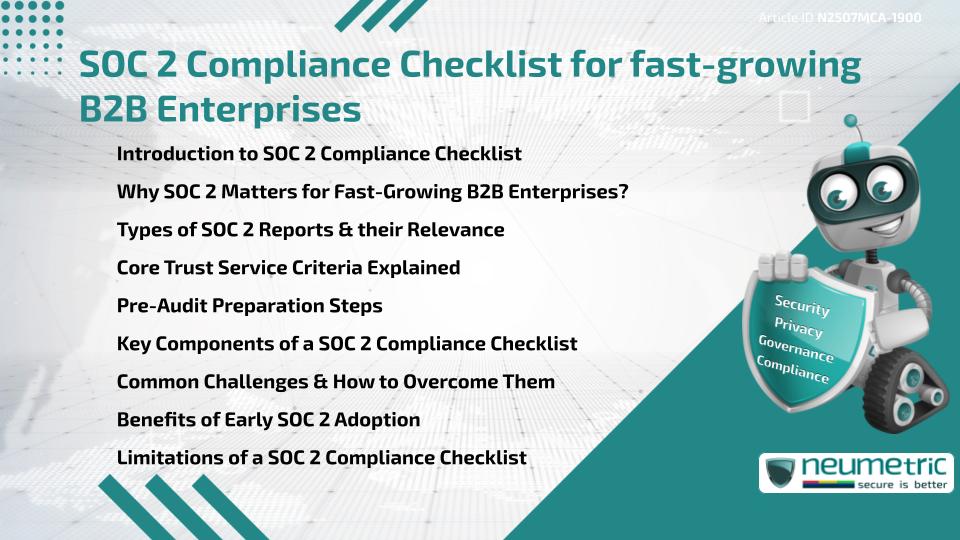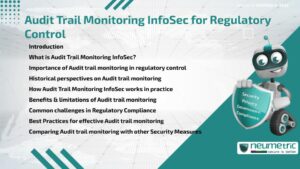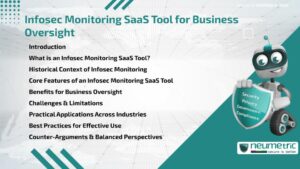Table of Contents
ToggleIntroduction to SOC 2 Compliance Checklist
A SOC 2 Compliance Checklist is a crucial resource for fast-growing B2B enterprises that need to assure clients & Stakeholders about their commitment to security & Privacy. It outlines the necessary steps to prepare for a SOC 2 Audit & maintain alignment with the five Trust Service Criteria defined by the American Institute of Certified Public Accountants [AICPA]. For B2B enterprises operating in sectors like technology, Finance or Healthcare, SOC 2 compliance often becomes a non-negotiable factor in winning contracts & building trust.
This article explores what a SOC 2 Compliance Checklist entails, its relevance to fast-scaling businesses, the structure of SOC 2 reports & how to implement compliance systematically. Whether you’re at the start of your compliance journey or scaling up operations, this guide will equip you with the knowledge needed to stay secure & Audit-ready.
Why SOC 2 Matters for Fast-Growing B2B Enterprises?
SOC 2 compliance isn’t just a box to tick-it represents a company’s ability to safeguard Customer Data & operate securely in a competitive market. As B2B enterprises scale, they often handle increasing volumes of Sensitive Information, Third Party integrations & regulatory scrutiny.
SOC 2 audits assess internal controls related to Data Security & help companies demonstrate their credibility. In sectors like Software as a Service [SaaS] or managed IT services, clients demand proof of strong information handling practices.
Without a defined SOC 2 Compliance Checklist, companies Risk delays in onboarding enterprise clients or losing trust from existing partners. Fast-growing firms must embed compliance into their operational DNA early on to avoid reactive firefighting later.
Learn more about why SOC 2 is critical in modern tech
Types of SOC 2 Reports & their Relevance
SOC 2 reports come in two types:
- Type I assesses the design of security processes at a single point in time
- Type II evaluates operational effectiveness over a period
For fast-growing enterprises, a Type I report is often the first step. It allows teams to validate their control Framework. A Type II report offers a stronger signal of reliability, especially when dealing with high-value or long-term contracts.
Understanding the distinction helps in tailoring your SOC 2 Compliance Checklist to your current business phase & strategic goals.
Core Trust Service Criteria Explained
The SOC 2 Framework is based on five Trust Service Criteria:
- Security – Safeguards against unauthorised access
- Availability – System accessibility & uptime
- Processing Integrity – System accuracy & completeness
- Confidentiality – Restricted Data Protection
- Privacy – Personal Information handling
Your SOC 2 Compliance Checklist should address how each of these is operationalised. For example, under Security, checklist items may include multi-factor authentication & network segmentation. For Availability, redundancy planning & uptime monitoring are critical.
More on AICPA Trust Services Criteria
Pre-Audit Preparation Steps
Before starting a formal SOC 2 Audit, businesses need to conduct internal readiness assessments. This phase helps identify gaps & plan remediations.
Key pre-Audit activities include:
- Mapping current IT & operational controls to SOC 2 criteria
- Identifying owners for each control
- Reviewing documentation Policies
- Implementing a compliance management platform if necessary
This foundational effort ensures that the SOC 2 Compliance Checklist doesn’t become a reactive checklist but an embedded practice across teams.
Key Components of a SOC 2 Compliance Checklist
An effective SOC 2 Compliance Checklist typically includes:
- Data classification & Access Control Policies
- Incident Response planning
- Encryption in transit & at rest
- Employee onboarding/offboarding workflows
- Vendor Risk Management protocols
- Change management Policies
- Backup & Disaster Recovery procedures
- Continuous Monitoring & logging
- Security awareness training
Each item should be clearly mapped to the relevant Trust Service Criteria. This ensures traceability & streamlines auditor reviews.
Common Challenges & How to Overcome Them
Even with a well-prepared checklist, sometimes B2B enterprises face challenges:
- Lack of resources – Small teams often multitask, leading to control oversight
- Tool sprawl – Disconnected systems make monitoring difficult
- Poor documentation – If it’s not written down, it doesn’t exist for auditors
- Evolving Threats – New Risks can outpace static checklists
To overcome these, businesses should invest in centralised compliance tools, assign dedicated compliance officers & adopt agile documentation practices.
Benefits of Early SOC 2 Adoption
Fast-growing enterprises that embrace SOC 2 early enjoy several benefits:
- Faster sales cycles with enterprise clients
- Stronger brand credibility & trust
- Improved internal processes & accountability
- Easier expansion into regulated markets
Moreover, a well-maintained SOC 2 Compliance Checklist becomes a living document that evolves with the business.
Limitations of a SOC 2 Compliance Checklist
While helpful, checklists have limitations:
- They focus on what needs to be done, not how effectively it’s done
- They can become outdated if not maintained
- They may give a false sense of security if misused
Checklists are best used in conjunction with ongoing training, Threat assessments & leadership involvement in Governance.
Takeaways
- The SOC 2 Compliance Checklist helps B2B enterprises build trust & win clients
- Early preparation & readiness assessments are essential
- The checklist must align with the five Trust Service Criteria
- A checklist is a tool-not a substitute-for active Risk Management
FAQ
What is a SOC 2 Compliance Checklist?
A SOC 2 Compliance Checklist is a structured guide that outlines the Policies, controls & procedures an organisation must implement to meet SOC 2 Audit requirements.
Who needs to follow a SOC 2 Compliance Checklist?
Any B2B enterprise handling Customer Data-especially in the tech or SaaS industry-should follow a SOC 2 Compliance Checklist to ensure secure operations & build Customer Trust.
How long does it take to become SOC 2 compliant?
It typically takes three (3) to six (6) months to prepare for a Type I report & another six (6) to twelve (12) months for a Type II report, depending on the business’s current maturity.
Can startups use a SOC 2 Compliance Checklist?
Yes, startups benefit greatly from using a SOC 2 Compliance Checklist early. It helps in still good security practices & makes scaling smoother.
How often should the SOC 2 Compliance Checklist be updated?
It should be reviewed quarterly & updated whenever significant changes occur in infrastructure, regulations or Threat landscapes.
Is SOC 2 compliance legally required?
No, SOC 2 compliance is not a legal requirement but is often contractually demanded by clients, especially in highly regulated industries.
What are the consequences of not following the checklist?
Not following the checklist can lead to Audit failures, data breaches or loss of Client contracts due to lack of transparency & trust.
Need help for Security, Privacy, Governance & VAPT?
Neumetric provides organisations the necessary help to achieve their Cybersecurity, Compliance, Governance, Privacy, Certifications & Pentesting needs.
Organisations & Businesses, specifically those which provide SaaS & AI Solutions in the Fintech, BFSI & other regulated sectors, usually need a Cybersecurity Partner for meeting & maintaining the ongoing Security & Privacy needs & requirements of their Enterprise Clients & Privacy conscious Customers.
SOC 2, ISO 27001, ISO 42001, NIST, HIPAA, HECVAT, EU GDPR are some of the Frameworks that are served by Fusion – a SaaS, multimodular, multitenant, centralised, automated, Cybersecurity & Compliance Management system.
Neumetric also provides Expert Services for technical security which covers VAPT for Web Applications, APIs, iOS & Android Mobile Apps, Security Testing for AWS & other Cloud Environments & Cloud Infrastructure & other similar scopes. Reach out to us by Email or filling out the Contact Form…





